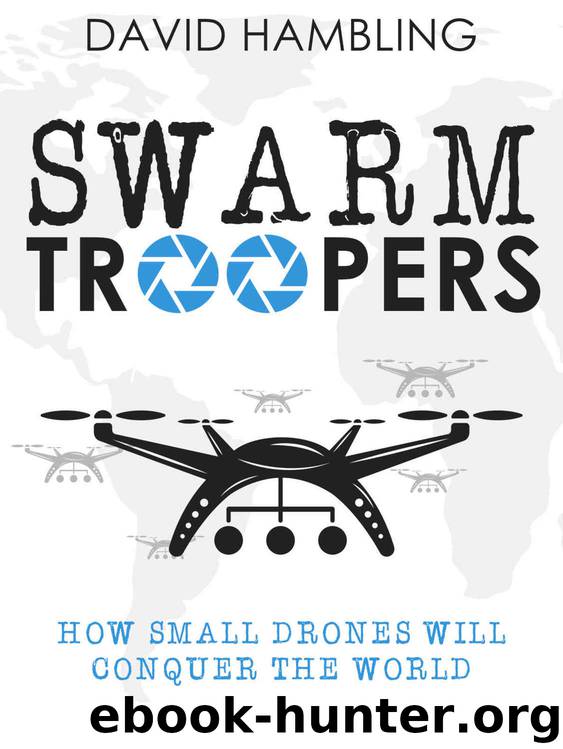Swarm Troopers: How small drones will conquer the word by David Hambling

Author:David Hambling [Hambling, David]
Language: eng
Format: epub, mobi
Published: 2015-12-09T18:30:00+00:00
Seeing through Walls
Radar has always been too big to fit on small drones, but predictably enough, it is also shrinking to fit. Much of this is due to the consumer side of the market, specifically the trend for radar in top-end automobiles.
Researchers at the University of Denver have developed miniature radar to allow small drones to sense and avoid other aircraft. Like LADAR, radar is useful because it works in all weather and at night. The prototype currently weighs twelve ounces, and it is being commercialized by Integrated Robotics Imaging Systems in Kenai, Alaska. The CEO, Joe Parker, estimates it will get down to four ounces. (10)
Some researchers are already suggesting that radar could be built into miniature drones. The Air Force Research Laboratory has funded work on a “smartphone radar” based on the idea that phones already incorporate the three essential components of a radar system: a radio transmitter, a receiver, and computing power. One smartphone on its own is limited, but researchers have looked at using three smartphones together to effectively create a single large antenna.
Most forms of radar are blocked by walls and other solid objects, but there are also through-the-wall “life detection” radars. These use ultra-wideband radio waves, which can go through solid walls as easily as air. Life detection radar works on the Doppler principle and only detects movement, in particular the movements associated with human life – breathing and heartbeats. First responders use portable units in rescue operations to detect if there are people alive in a building. It is imprecise but will give the number and approximate location of any people inside. The technology is also used by the military and police.
In 2013 Israeli company Camero demonstrated a radar system mounted on a small quadrotor – “Airborne structure penetrating life detection system” – which can land on a building and scan it for occupants. Again, this is less of a magical x-ray device that reveals everything, more of a rough indication of whether anyone is home.(11) A similar device for small quadcopters was unveiled by Intellinet Sensors of California in October 2015.
Another approach to through-the-wall sensing is to use existing signals that go through walls. These passive sensors do not require a transmitter of their own but sense objects via distortion in the signal from Wi-Fi networks. Obviously Wi-Fi signals can go through walls, though they are attenuated in the process, and they are affected by other solid objects including people.
In a sense this is an old idea, as the original work on radar in the 1930s was inspired by engineers noticing that radio signals were affected by planes flying past. Professor Karl Woodbridge and his colleagues at University College, London, have shown how it is possible to “uncooperatively and covertly” detect people moving from the other side of a wall. (12) Woodbridge says a more refined version of the technology could detect breathing, so even staying still would not conceal you from it. MIT researchers are looking at a similar system that
Download
Swarm Troopers: How small drones will conquer the word by David Hambling.mobi
This site does not store any files on its server. We only index and link to content provided by other sites. Please contact the content providers to delete copyright contents if any and email us, we'll remove relevant links or contents immediately.
The Radium Girls by Kate Moore(11573)
100 Deadly Skills by Clint Emerson(4653)
The Templars by Dan Jones(4539)
Rise and Kill First by Ronen Bergman(4531)
The Doomsday Machine by Daniel Ellsberg(4224)
The Rape of Nanking by Iris Chang(3998)
Killing England by Bill O'Reilly(3885)
Hitler in Los Angeles by Steven J. Ross(3781)
Stalin by Stephen Kotkin(3699)
12 Strong by Doug Stanton(3400)
Hitler's Monsters by Eric Kurlander(3135)
Blood and Sand by Alex Von Tunzelmann(3032)
Darkest Hour by Anthony McCarten(3001)
The Code Book by Simon Singh(2829)
The Art of War Visualized by Jessica Hagy(2815)
Hitler's Flying Saucers: A Guide to German Flying Discs of the Second World War by Stevens Henry(2612)
Babylon's Ark by Lawrence Anthony(2416)
The Second World Wars by Victor Davis Hanson(2410)
Tobruk by Peter Fitzsimons(2364)
